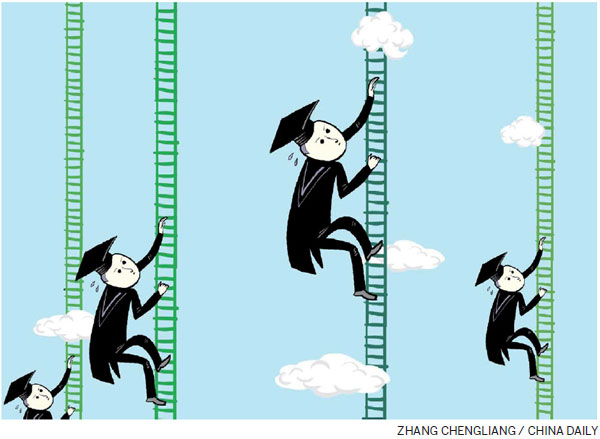Chinese universities climb global ladder

Now these world-class educational institutions need to share their good fortune with country's poorer regions
Once again the QS World University Rankings have been published and once again a notable feature is the continued rise of universities on the Chinese mainland. Not only have they increased their overall share of places, they have also increased their share of top 50 places (up from 65 in 2016 to 79 for 2017).
Overall, four Chinese universities occupy positions inside the top 100, Tsinghua (equal 24th), Peking University (39th), Fudan (43rd) and Shanghai Jiao Tong (61st). In addition, a further three sit on the cusp of the top 100 with the University of Science and Technology of China (equal 104th), Zhejiang (110th) and Nanjing University (equal 115th).
Chinese universities are also leading the way across Asia, making up almost a quarter of the top 100 ranked universities in this region.

The QS World University Rankings is one of the most highly respected and widely acknowledged reports on the global university sector, which makes the rise of China's universities all the more impressive.
Before going any further it is important to detail the methodology and rigor that lies behind the QS rankings. Four factors are taken into account when assessing a university's global competitiveness: academic reputation, employer reputation, research citations per paper and overall impact of published research. In compiling the 2017 rankings, almost 75,000 academics worldwide were surveyed and just over 40,000 graduate employers worldwide who were surveyed in an attempt to measure the employability of a university's graduates.
For the first time a graduate employability ranking has been compiled and Chinese universities can boast very impressive performances, with Tsinghua climbing well inside the global top 10 at number 3 and Peking just outside the top 10 in 11th spot. Fudan follows close behind, ranked 14th. Not that far behind sit Shanghai Jiaoting in 33rd place and Zhejiang University, ranked 36th.

Four Chinese universities are in the top 50 graduate employability world rankings and five in the top 100, with Huazhong University of Science and Technology, based in central China's Wuhan, achieving a ranking of 71-80.
The final two factors aim to measure the strength of a university's published research output and here again China's highest ranked universities have put in impressive performances.
As more and more Chinese brands achieve international recognition, the country's universities are following on fast.
Also for the first time this year the QS report contained a "Best Student City" ranking. From December 2016 until the end of January 2017, more than 1,800 students and graduates were surveyed. They were asked to rate the city in which they went to university according to eight categories: arts and culture, affordability, nightlife, employment opportunities, diversity, tolerance and inclusion, ease of getting around and friendliness. Finally, the survey asked whether they would stay or had stayed in the city after graduating.
Good news here too for China and its university cities, with Shanghai reaching third place in the rankings. The second largest city featured in the index, after Tokyo, the city was actually rated very highly in the "ease of getting around" category. Shanghai also scored very strongly on nightlife, friendliness and, of course, arts and culture. Those surveyed also praised very highly the city's cuisine and opportunities to meet people from a variety of cultural backgrounds and the overall buzz of the city considered to hold increasing international opportunities and influence.
Not that Shanghai was the only Chinese city to achieve recognition via this new ranking. Nanjing achieved the highest rating for "tolerance and inclusion".
The 2017 subject rankings are another success for Chinese universities. Taking science and engineering first, Tsinghua climbed into the top 10 (ranked seventh) for category Electrical Engineering. Tsinghua's impressive showing in this subject category was almost matched by Peking Unversity (22nd), Shanghai Jiaotong (37th) and Zhejiang University (equal 46th). While Fudan and the University of Science and Technology of China both placed in top 100, making six Chinese universities in total inside the world's top 100 for Electrical Engineering. Quite a feat.
The same six also made the world's top 100 in the Computer Science category, where Tsinghua once again came out on top (15th) with Peking right behind (equal 16th) and Shanghai Jiaotong also inside the world's top 50 at No 46. Fudan, Zhejiang and the University of Science and Technology of China also made the top 100.
Not that the rankings were dominated exclusively by these top institutions. Tianjin University climbed into the world's top 100 ranked universities for the subject category Chemical Engineering and Renmin University sits of China just outside the world's top 100 Universities for the Business and Management subject category.
In the Materials Science subject category, the Beijing Institute of Technology and the Harbin Institute of Technology both made the world's top 100 and China's Institute of Tourism Studies has been ranked 18th in the Hospitality and Leisure Management subject category.

The Beijing Institute of Technology also occupies a proud place in the world's top 100 universities for the Mechanical Engineering subject category, a category for which no fewer than seven Chinese universities have been placed inside the world's top 100 and four inside the top 50.
And it is not just the subject rankings where an increasing spread of Chinese universities are making their mark. The top 100 universities across the Asia region include Beijing Normal University in the 40th spot and Wuhan University (ranked 44th) and Sun Yat-sen (ranked 47th) inside the top 50. Just outside Asia's top 50 sit Tongji (53rd), Xi'an Jiaotong (56th) and Nankai (57th).
Tongji University also achieved a ranking of equal 34th for the Art and Design subject category. This subject category contained a total of four Chinese universities in the top 50 (Tsinghua, Peking, Tongji and Shanghai Jiaotong) and five in the top 100 ( including the University of Science and Technology of China).
And it is in the area of the arts that further success appears for Chinese universities. For the subject category, Modern Languages, there are a staggering seven Chinese universities inside the world's top 100. Tsinghua once again makes the world's top 10 for this subject category, ranked eighth and Beijing Foreign Studies University climbs into the top 100.
Impressive rankings achieved in arts subjects is confirmed with three Chinese universities placed inside the world's top 100 for History (Peking, Fudan and Tsinghua).
Amid all this good news for China's University sector, it is important to note that little to no representation can be found in this year's QS World University Rankings from universities in West China and other less-developed parts of the Chinese mainland. Investment, both public and private, is much-needed there and the development of world-class universities in these poorer regions is vital for the sustainable, long-term economic development of these regions.
It is also incumbent on the top performing universities such as Tsinghua, Peking, Fudan, Shanghai Jiaotong, Zhejiang and Nanjing to expedite the development of internationally competitive universities across Western China. This could take the form of collaboration but could also see these top performing universities launching new branches in western Chinese cities.
Let's hope the global rise and rise of Chinese universities spreads across China and rapidly.
The author is a visiting professor at the University of International Business and Economics in Beijing and a senior lecturer at Southampton University.
The views do not necessarily reflect those of China Daily.
(China Daily European Weekly 03/24/2017 page11)
Today's Top News
- International community must push for de-escalation in the Middle East
- Middle East tensions nearing climax
- Xi returns to Beijing after attending 2nd China-Central Asia Summit
- Xi leaves Astana after attending China-Central Asia Summit
- Multifaceted partnership has entered a new stage
- Global firms optimistic about China's market potential






























